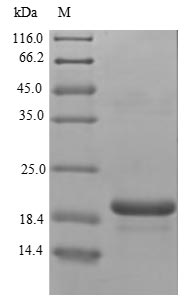Recombinant Escherichia coli Nickel-responsive regulator (nikR) is produced using an E. coli expression system and contains the full-length protein spanning 1-133 amino acids. The recombinant protein includes an N-terminal 6xHis-tag, which helps with purification and detection processes. SDS-PAGE analysis confirms a purity level greater than 90%. This product is intended for research use only and comes without endotoxin level specifications.
NikR appears to function as a transcriptional regulator in Escherichia coli, with its primary role being nickel ion homeostasis. The protein works by binding to DNA in response to nickel ion concentration, which then regulates the expression of genes linked to nickel uptake and usage. This protein likely plays a crucial role in maintaining cellular metal ion balance, making it an important focus for bacterial metal ion regulation research.
Potential Applications
Note: The applications listed below are based on what we know about this protein's biological functions, published research, and experience from experts in the field. However, we haven't fully tested all of these applications ourselves yet. We'd recommend running some preliminary tests first to make sure they work for your specific research goals.
E. coli NikR is a bacterial metalloregulatory protein that requires nickel binding and proper tetramerization for its DNA-binding activity. The E. coli expression system is homologous to this protein, significantly increasing the probability of correct folding and tetramer formation. The N-terminal 6xHis tag is small (∼2 kDa) and unlikely to sterically interfere with the protein's functional domains or oligomerization. Therefore, this recombinant NikR has a high probability of being correctly folded and functionally active for nickel-responsive DNA binding.
1. Protein-DNA Interaction Studies Using EMSA
This recombinant NikR is suitable for studying DNA-binding properties through EMSA. The homologous expression system and small His-tag ensure native conformation. Researchers can investigate nickel-dependent binding to promoter sequences with high reliability. The >90% purity minimizes non-specific interactions in gel shift assays. Any interaction data would be biologically irrelevant without validation using a natively folded protein.
2. Metal Ion Binding Characterization Through Biophysical Analysis
This protein is ideal for detailed biophysical studies of nickel binding using ITC, DSF, or spectroscopic methods. The high purity enables accurate measurement of binding stoichiometry, affinity, and thermodynamic parameters. Nickel-induced conformational changes can be reliably monitored.
3. Antibody Development and Immunoassay Applications
This recombinant NikR serves as an excellent immunogen for generating specific antibodies. The full-length sequence with minimal tag ensures comprehensive epitope coverage. Antibodies will reliably recognize the native protein in bacterial samples.
4. Protein-Protein Interaction Screening Using His-Tag Pull-Down Assays
This application is conditionally suitable but carries moderate risk. While the His-tag enables pull-down experiments, NikR's physiological function focuses on DNA binding rather than extensive protein partnerships. Results may identify specific regulators but require validation against non-specific binding. Although correctly folded, NikR's primary role is nucleic acid interaction; protein partners may be limited and require careful validation.
Final Recommendation & Action Plan
This recombinant NikR expressed in its homologous E. coli system with a minimal His-tag is highly likely to be properly folded and functionally active, making it suitable for most proposed applications. The recommended approach is to begin with Application 2 (Metal Ion Binding Characterization) to confirm nickel-binding activity and establish baseline functional parameters. Once activity is verified, proceed confidently with Applications 1 and 3 (DNA-binding studies and antibody development). For Application 4 (Interaction Studies), use nickel-supplemented conditions and include appropriate controls to distinguish specific from non-specific interactions. This systematic validation ensures reliable results across all experimental paradigms, with the protein being particularly well-suited for its core functional studies of metal-responsive gene regulation.






